|
Shift Register |
|
Shift Register |

|
EOS |
|
Instruments |

|
webpages and Eos image copyright 2016 M Nealon |
|
Part A, Hardware. |
|
Hardware construction exercise, and a PicAxe programming exercise.
The PicAxe 08M2 microprocessor drives a shift register in order to illuminate eight LED’s. The illumination patterns are designed by individual programmers. Various patterns may be switch selected.
The number of such patterns is limited by the imagination of the programmer or the size of the microprocessor. The speed with which the processor runs through each pattern is varied by adjustment of a potentiometer.
First the hardware is laid out, assembled and soldered together. Then the program is written and downloaded onto the microprocessor. |
|
Since this project is based on the PicAxe 08M2 microprocessor, the Proto Board Kit is the simplest method to arrange a circuit for downloading the program. Also, there happens to be just enough space on the board to place the shift register and debounce circuit. This Proto Board is then mounted on a breadboard along with the LED’s and their corresponding limiting resistors. The pattern selector switch and speed controlling potentiometer are also mounted on the breadboard. |
|
Bill of Materials PicAxe 08M2 Proto Board Kit and 08M2 microprocessor 10 kΩ resistor 560 Ω resistor 1 μF capacitor Momentary contact switch 5 kΩ 10-turn potentiometer SN54HC595 shift register, Texas Instruments 16-pin DIP socket (8) 470 Ω resistors (8) LED’s Battery holder, 4.5 V Breadboard and other mounting hardware |



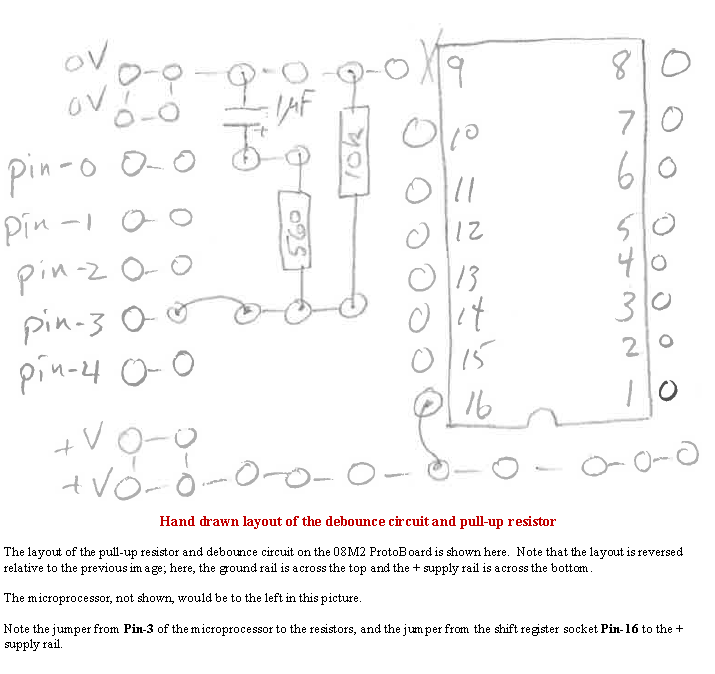
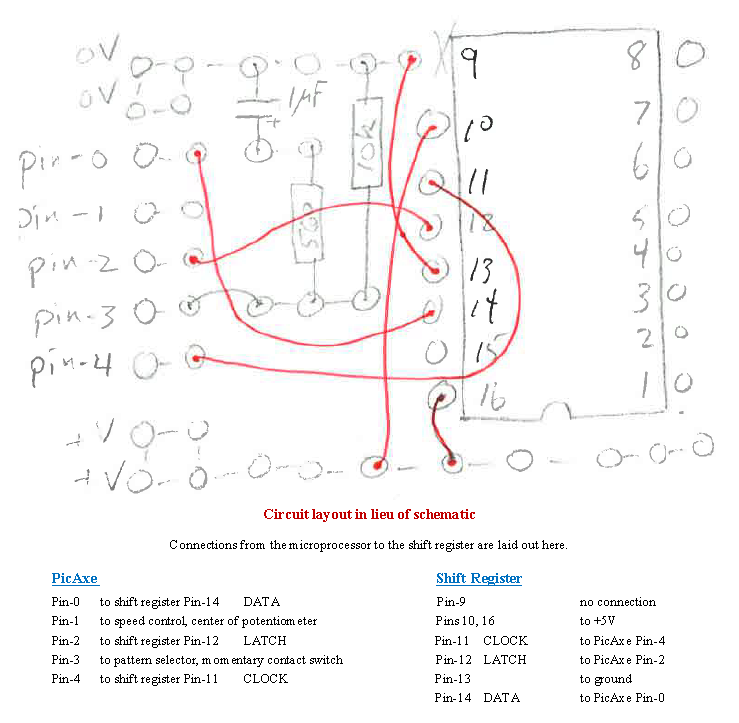

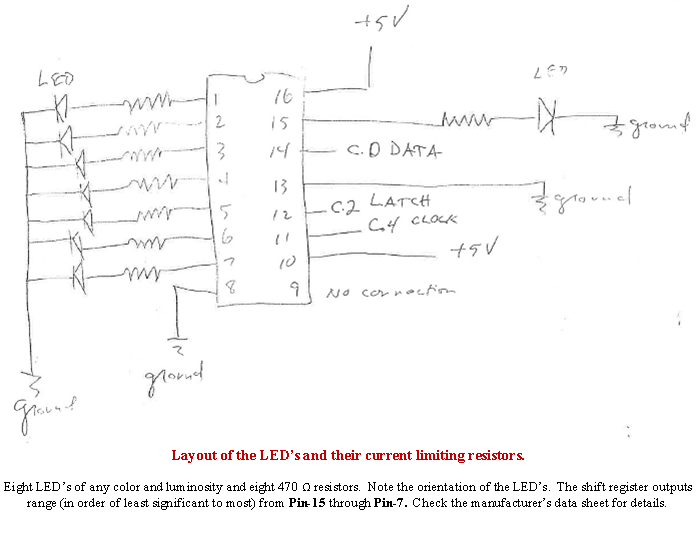
|
Part B, Software. |
|
The overall plan of the program may be outlined as a flowchart in the PicAxe Programming Editor. Generally, refinements to the plan must be made by hand in Basic language. |
|
PicAxe 08M2 |

|
The breadboard.
The blank Proto Board is shown. The cork is used to underlie the circuit board. The LED’s and resistors are soldered onto the 3 x 8 array of brass-plated nails. The battery holder is attached. |

|
The program runs continuously in a loop.
An eight-bit byte is used as a single on/off sequence for lighting the eight LED’s. Let’s call a collection of these sequences a “pattern”. The patterns may have as many or as few sequences as desired by the programmer. The small 08M2 microprocessor is large enough to program several patterns, if desired. The momentary contact switch is used to step through these patterns.
The simplest method to keep track of these various patterns is to use an index. An interrupt command, then, can be used to read the momentary contact switch. Upon each press of the switch, the index increments and the next pattern is sent to the LED’s. After the last pattern is displayed, the index is reset to zero.
The time during which the LED’s stay lit is set inside the programmed routine. Periodically, the program reads the input pin attached to the speed control potentiometer and adjusts this delay time.
Perhaps the most efficient method of sending a sequence to the shift register is to call a subroutine. In the subroutine, each bit is CLOCKED in series along the DATA line. The shift register stores all eight bits in temporary registers, then on LATCH command from the microprocessor, will shift the eight bits in parallel to its eight outputs, thus lighting the LED’s. |
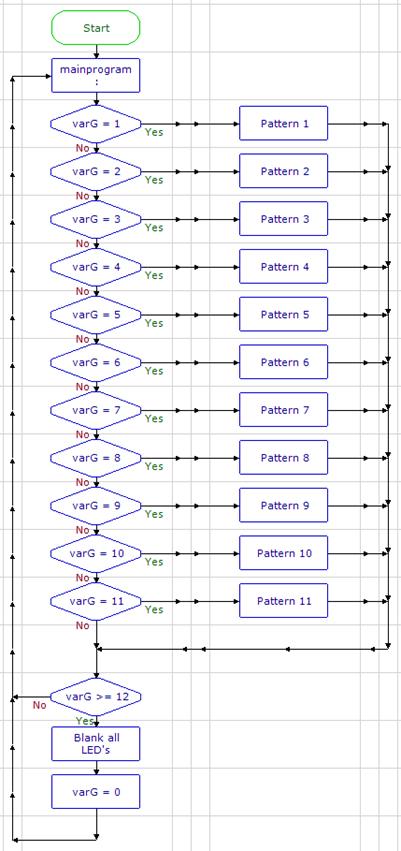
|
Overall scheme for the program in Flowchart form.
This program allows for eleven patterns. A variable, with default name “varG”, is used for the index. The box “mainprogram” initiates the program and consists of code written in Basic language.
If the momentary contact switch is pressed twelve times, all LED’s are turned off and the index is reset to zero. The program then loops, waiting for the switch to be pressed again. |
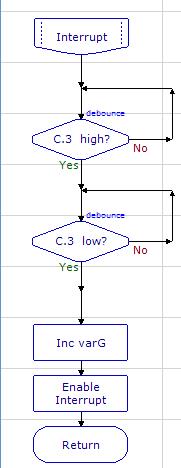
|
Interrupt routine.
The interrupt command works only if it is “enabled”. This command is disabled each time it is used so it must be enabled each time the switch is pressed. The first enable is in the Basic block “mainprogram”. The enable command is repeated at the end of the interrupt routine.
The interesting thing about the interrupt command is that it may be use on more than one pin at a time. The logic of using multiple pins is that you must “mask” the inputs; that is, you must tell the processor which pins to look at for possible interrupts. Also, you may tell the processor to interrupt on a “high” input or “low” input. Furthermore, you must tell the processor whether you wish to interrupt the current program if all (AND) of the selected pins are in the condition you have set, or if any are in the conditions you have set. For use of a single pin, the OR condition is used by default.
In this interrupt routine, the “C.3 high?” and “C.3 low?” questions are a software debounce. This is not really necessary since we have the hardware debounce, so it may be deleted if a few extra lines of code are needed for something else.
Each time an interrupt is called, the program returns to the place where it was interrupted. |

|
Examples of patterns. |

|
mainprogram: let dirsC = 1
symbol dataline=c.0 symbol clockline=c.4 symbol latch=c.2 symbol switch1=c.3 symbol potentiometer=c.1
symbol val = b0 symbol temp1 = b1 symbol j = b2 symbol i = b3 symbol indexstep = b4 symbol sequence = b5
symbol delay = w7 symbol pausetime=w8
let varG = 0 setint OR 8, 8
readadc potentiometer, delay pausetime=delay*8 |
|
Mainprogram:
Symbols are defined here. The index, varG, is set to zero.
The interrupt is enabled by the “setint” command. The “OR” condition is used with a single pin. The decimal numeral “8” corresponds to the binary number 00001000. One of the numerals “8” is the mask, referring to pin C.3, and the other “8” refers to the condition “high” on that pin.
“readadc” is the command to read the analog-to-digital-converter at pin C.1, the result of which is placed into the variable “delay”. The analog value ranges from zero to 4.5 volts; the corresponding digital value ranges from zero to 255. This maximum digital number is roughly the number of milliseconds in a quarter-second, so if you were to multiply “delay” by eight, the maximum delay would be about two seconds.
Here’s how to blank all LED’s:
sequence = %00000000 gosub outsequence |
|
if varG = 1 then goto Cell_10_2 end if if varG = 2 then goto Cell_10_6 end if if varG = 3 then goto Cell_10_10 end if if varG = 4 then goto Cell_10_14 end if if varG = 5 then goto Cell_10_18 end if if varG = 6 then goto Cell_10_22 end if if varG >= 7 then goto Cell_7_36 end if |
|
Index queries.
Showing only six possible patterns. The cell numbers are just default line numbers for the goto commands. |

|
Outsequence subroutine.
This subroutine is called each time a sequence of eight bits is required to be sent to the shift register. The idea is to step each bit of the 8-bit byte into the least significant place and send them in turn down the DATA line to the shift register. The shift register moves the bits down it’s line into eight temporary registers.
“sequence” is the eight-bit byte to illuminate the LED’s.
The “for . . . next” loop sends that sequence in series down the “dataline”.
The “&%00000001” is a mask which places only the least significant bit of “val” in the variable “temp1”.
“pulsout clockline, 1” clocks the single bytes down the line of temporary registers.
Each time the “val = val/2” command is executed in the loop, the bits are shifted down the byte one place to the right. For example, the decimal number 16 is represented in binary as 00010000. In order to shift that 1 to the right one place, divide by 2: 16/2 = 8, or in binary, 00001000. |
|
'send sequence to shift register outsequence: j=sequence val = j for i = 1 to 8 temp1 = val &%00000001 if temp1 = 1 then high dataline else low dataline endif pulsout clockline,1 val = val/2 next i pulsout latch,1
return |
|
'pattern 4 x 4 sequence = %11110000 pause pulsetime gosub outsequence 'pattern 4 x 4 sequence = %00001111 pause pulsetime gosub outsequence |
|
'pattern 7 sequence = %10000000 pause pausetime gosub outsequence
sequence = %01000000 pause pausetime gosub outsequence
sequence = %00100000 pause pausetime gosub outsequence
sequence = %00010000 pause pausetime gosub outsequence
sequence = %00001000 pause pausetime gosub outsequence
sequence = %00000100 pause pausetime gosub outsequence
sequence = %00000010 pause pausetime gosub outsequence
sequence = %00000001 pause pausetime gosub outsequence
|
|
Part C, Extension to 16-Bits. |
|
In order to extend the project to 16 LED’s we need to make a few changes, but not too many.
In the software, we first need to redefine the variables in the “mainprogram” from 8-bit bytes to 16-bit words.
Change all of the sequences to 16-bit words.
In the “outsequence” subroutine, change the “for . . . next” loop to 1 through 16. The mask must be a 16-Bit word, %0000000000000001.
In the hardware, connect the first shift register in just the same way as for the 8-bit case with one exception: connect Pin-9, OUPUT, of the first shift register to Pin-14, DATA, of the second shift register. Additionally, connect Pins 10—13 of the second shift register in parallel with the same pins on the first shift register. On the second shift register, Pin-9 has no connection. |


|
'column 1 { ;Symbols symbol varA = b0 symbol varB = b1 symbol varC = b2 symbol varD = b3 symbol varE = b4 symbol varF = b5 symbol varG = b6 symbol varH = b7 symbol varI = b8 symbol varJ = b9 symbol varK = b10 symbol varL = b11 symbol varM = b12 symbol varN = b13 symbol varO = b14 symbol varP = b15 symbol varQ = b16 symbol varR = b17 symbol varS = b18 symbol varT = b19 symbol varU = b20 symbol varV = b21 symbol varTEMPBYTE1 = b22 symbol varTEMPBYTE2 = b23 symbol varTEMPBYTE3 = b24 symbol varTEMPBYTE4 = b25 symbol varTEMPBYTE5 = b26 symbol varTEMPBYTE6 = b27 symbol varTEMPWORD1 = w11 symbol varTEMPWORD2 = w12 symbol varTEMPWORD3 = w13 }
main:
symbol dataline=c.0 symbol clockline=c.4 symbol latch=c.2 symbol switch1=c.3 symbol potentiometer=c.1
symbol val = w0 symbol temp1 = w1
symbol j = w2 symbol i = w4 symbol indexstep = w5 symbol sequence = w6 symbol delay = w7 symbol pausetime=w8 symbol k = w9 symbol m = b21
'pattern blank sequence = %0000000000000000 gosub outsequence pause 400 let varG = 0 setint OR 8, 8 Cell_7_2: mainprogram: readadc potentiometer, delay pausetime=delay*2 if varG = 1 then goto Cell_10_4 end if if varG = 2 then goto Cell_10_8 end if if varG = 3 then goto Cell_10_11 end if if varG = 4 then goto Cell_10_16 end if if varG = 5 then goto Cell_10_20 end if if varG = 6 then goto Cell_16_24 end if if varG = 7 then goto Cell_10_35 end if if varG = 8 then goto Cell_10_41 end if if varG = 9 then goto Cell_10_54 end if if varG = 10 then goto Cell_10_59 end if if varG = 11 then goto Cell_10_77 end if if varG = 12 then goto Cell_10_81 end if Cell_7_87: if varG >= 13 then goto Cell_7_89 end if goto Cell_7_2
Cell_7_89: 'pattern blank sequence = %0000000000000000 j=sequence val = j for i = 1 to 16 temp1 = val &%000000000000001 if temp1 = 1 then high dataline else low dataline endif pulsout clockline,1 val = val/2 next i
pulsout latch,1
pause 400
let varG = 0
goto Cell_7_2
Cell_10_81: 'pattern 12 varU = varG sequence = %0100010001000100 pause pausetime gosub prc_outsequence 'pattern 12 sequence = %1000100010001000 pause pausetime gosub prc_outsequence goto Cell_7_87
prc_outsequence: 'send sequence to shift register
if varG <> varU then goto mainprogram: endif j=sequence val = j for i = 1 to 16 temp1 = val &%000000000000001 if temp1 = 1 then high dataline else low dataline endif pulsout clockline,1 val = val/2 next i
pulsout latch,1
return
Cell_10_77: 'pattern 11 varU = varG sequence = %0010001000100010 pause pausetime gosub prc_outsequence 'pattern 11 sequence = %0001000100010001 pause pausetime gosub prc_outsequence goto Cell_7_87
Cell_10_59: 'pattern 10 varU = varG sequence = %1111111111111111 pause pausetime gosub prc_outsequence 'pattern 10 sequence = %0111111111111111 pause pausetime gosub prc_outsequence 'pattern 10 sequence = %1011111111111111 pause pausetime gosub prc_outsequence 'pattern 10 sequence = %1101111111111111 pause pausetime gosub prc_outsequence 'pattern 10 sequence = %1110111111111111 pause pausetime gosub prc_outsequence 'pattern 10 sequence = %1111011111111111 pause pausetime gosub prc_outsequence 'pattern 10 sequence = %1111101111111111 pause pausetime gosub prc_outsequence 'pattern 10 sequence = %1111110111111111 pause pausetime gosub prc_outsequence 'pattern 10 sequence = %1111111011111111 pause pausetime gosub prc_outsequence 'pattern 10 sequence = %1111111101111111 pause pausetime gosub prc_outsequence 'pattern 10 sequence = %1111111110111111 pause pausetime gosub prc_outsequence 'pattern 10 sequence = %1111111111011111 pause pausetime gosub prc_outsequence 'pattern 10 sequence = %1111111111101111 pause pausetime gosub prc_outsequence 'pattern 10 sequence = %1111111111110111 pause pausetime gosub prc_outsequence 'pattern 10 sequence = %1111111111111011 pause pausetime gosub prc_outsequence 'pattern 10 sequence = %1111111111111101 pause pausetime gosub prc_outsequence 'pattern 10 sequence = %1111111111111110 pause pausetime gosub prc_outsequence 'pattern 10 sequence = %1111111111111111 pause pausetime gosub prc_outsequence 'pattern 10 sequence = %1111111111111110 pause pausetime gosub prc_outsequence 'pattern 10 sequence = %1111111111111101 pause pausetime gosub prc_outsequence 'pattern 10 sequence = %1111111111111011 pause pausetime gosub prc_outsequence 'pattern 10 sequence = %1111111111110111 pause pausetime gosub prc_outsequence 'pattern 10 sequence = %1111111111101111 pause pausetime gosub prc_outsequence 'pattern 10 sequence = %1111111111011111 pause pausetime gosub prc_outsequence 'pattern 10 sequence = %1111111110111111 pause pausetime gosub prc_outsequence 'pattern 10 sequence = %1111111101111111 pause pausetime gosub prc_outsequence 'pattern 10 sequence = %1111111101111111 pause pausetime 'pattern 10 sequence = %1111111011111111 pause pausetime gosub prc_outsequence 'pattern 10 sequence = %1111110111111111 pause pausetime gosub prc_outsequence 'pattern 10 sequence = %1111101111111111 pause pausetime gosub prc_outsequence 'pattern 10 sequence = %1111011111111111 pause pausetime gosub prc_outsequence 'pattern 10 sequence = %1110111111111111 pause pausetime gosub prc_outsequence 'pattern 10 sequence = %1101111111111111 pause pausetime gosub prc_outsequence 'pattern 1 sequence = %1011111111111111 pause pausetime gosub prc_outsequence 'pattern 10 sequence = %0111111111111111 pause pausetime gosub prc_outsequence goto Cell_7_87
Cell_10_54: 'pattern 9 varU = varG sequence = %0000000000000000 pause pausetime gosub prc_outsequence 'pattern 9 sequence = %1111111111111111 pause pausetime gosub prc_outsequence goto Cell_7_87
Cell_10_41: 'pattern 8 varU = varG sequence = %0000000110000000 pause pausetime gosub prc_outsequence 'pattern 8 sequence = %0000001001000000 pause pausetime gosub prc_outsequence 'pattern 8 sequence = %0000010000100000 pause pausetime gosub prc_outsequence 'pattern 8 sequence = %0000100000010000 pause pausetime gosub prc_outsequence 'pattern 8 sequence = %0001000000001000 pause pausetime gosub prc_outsequence 'pattern 8 sequence = %0010000000000100 pause pausetime gosub prc_outsequence 'pattern 8 sequence = %0100000000000010 pause pausetime gosub prc_outsequence 'pattern 8 sequence = %1000000000000001 pause pausetime gosub prc_outsequence 'pattern 8 sequence = %0000000000000000 pause pausetime gosub prc_outsequence 'pattern 8 sequence = %1000000000000001 pause pausetime gosub prc_outsequence 'pattern 8 sequence = %0100000000000010 pause pausetime gosub prc_outsequence 'pattern 8 sequence = %0010000000000100 pause pausetime gosub prc_outsequence 'pattern 8 sequence = %0001000000001000 pause pausetime gosub prc_outsequence 'pattern 8 sequence = %0000100000010000 pause pausetime gosub prc_outsequence 'pattern 8 sequence = %0000010000100000 pause pausetime gosub prc_outsequence 'pattern 8 sequence = %0000001001000000 pause pausetime gosub prc_outsequence 'pattern 8 sequence = %0000000110000000 pause pausetime gosub prc_outsequence 'pattern 8 sequence = %0000000000000000 pause pausetime gosub prc_outsequence |
|
'column 2; append to end of column 1
'pattern 6 sequence = %1000000000000001 pause pausetime gosub prc_outsequence 'pattern 6 sequence = %0100000000000010 pause pausetime gosub prc_outsequence 'pattern 6 sequence = %0010000000000100 pause pausetime gosub prc_outsequence 'pattern 6 sequence = %0001000000001000 pause pausetime gosub prc_outsequence 'pattern 6 sequence = %0000100000010000 pause pausetime gosub prc_outsequence 'pattern 6 sequence = %0000010000100000 pause pausetime gosub prc_outsequence 'pattern 6 sequence = %0000001001000000 pause pausetime gosub prc_outsequence 'pattern 6 sequence = %0000000110000000 pause pausetime gosub prc_outsequence 'pattern 6 sequence = %0000000000000000 pause pausetime gosub prc_outsequence 'pattern 6 sequence = %0000000110000000 pause pausetime gosub prc_outsequence 'pattern 6 sequence = %0000001001000000 pause pausetime gosub prc_outsequence 'pattern 6 sequence = %0000010000100000 pause pausetime gosub prc_outsequence 'pattern 6 sequence = %0000100000010000 pause pausetime gosub prc_outsequence 'pattern 6 sequence = %0001000000001000 pause pausetime gosub prc_outsequence 'pattern 6 sequence = %0010000000000100 pause pausetime gosub prc_outsequence 'pattern 6 sequence = %0100000000000010 pause pausetime gosub prc_outsequence 'pattern 6 sequence = %1000000000000001 pause pausetime gosub prc_outsequence 'pattern 6 sequence = %0000000000000000 pause pausetime gosub prc_outsequence goto Cell_7_87
Cell_10_35: 'pattern 7 varU = varG sequence = %1110011111100111 pause pausetime gosub prc_outsequence 'pattern 7 sequence = %0001100000011000 pause pausetime gosub prc_outsequence 'pattern 7 sequence = %1110011001100111 pause pausetime gosub prc_outsequence 'pattern 7 sequence = %1111111111111111 pause pausetime gosub prc_outsequence 'pattern 7 sequence = %0111111001111110 pause pausetime gosub prc_outsequence 'pattern 7 sequence = %0011110000111100 pause pausetime gosub prc_outsequence 'pattern 7 sequence = %0001100000011000 pause pausetime gosub prc_outsequence 'pattern 7 sequence = %0000000000000000 pause pausetime gosub prc_outsequence goto Cell_7_87
Cell_16_24: 'pattern 6 varU = varG
sequence = 0 gosub outsequence pause pausetime
sequence = %0000000000000001 gosub outsequence pause pausetime
sequence = 1 for k = 1 to 15 sequence = sequence * 2 gosub outsequence pause pausetime next k
sequence = 0 gosub outsequence pause pausetime
sequence = 32768 gosub outsequence pause pausetime
for k = 1 to 15 sequence = sequence/2 gosub outsequence if varG <> 6 then gosub mainprogram: endif pause pausetime next k
pause pausetime goto Cell_7_87
Cell_10_20: 'pattern 5 varU = varG sequence = %1000000000000010 pause pausetime gosub prc_outsequence 'pattern 5 sequence = %0100000000000001 pause pausetime gosub prc_outsequence goto Cell_7_87
Cell_10_16: 'pattern 4 varU = varG sequence = %1100110011001100 pause pausetime gosub prc_outsequence 'pattern 4 sequence = %0011001100110011 pause pausetime gosub prc_outsequence goto Cell_7_87
Cell_10_11: 'pattern 3 varU = varG for m = 1 to 5 sequence = %1000000000000000 pause pausetime if varG <> varU then goto mainprogram: end if gosub outsequence sequence = %0000000000000001 pause pausetime if varG <> varU then goto mainprogram: end if gosub outsequence next m
for m = 1 to 5 sequence = %0100000000000000 pause pausetime if varG <> varU then goto mainprogram: end if gosub outsequence sequence = %0000000000000010 pause pausetime if varG <> varU then goto mainprogram: end if gosub outsequence next m
for m = 1 to 5 sequence = %0010000000000000 pause pausetime if varG <> varU then goto mainprogram: end if gosub outsequence sequence = %0000000000000100 pause pausetime if varG <> varU then goto mainprogram: end if gosub outsequence next m
for m = 1 to 5 sequence = %0001000000000000 pause pausetime if varG <> varU then goto mainprogram: end if gosub outsequence sequence = %0000000000001000 pause pausetime if varG <> varU then goto mainprogram: end if gosub outsequence next m
for m = 1 to 5 sequence = %0000100000000000 pause pausetime if varG <> varU then goto mainprogram: end if gosub outsequence sequence = %0000000000010000 pause pausetime if varG <> varU then goto mainprogram: end if gosub outsequence next m
for m = 1 to 5 sequence = %0000010000000000 pause pausetime if varG <> varU then goto mainprogram: end if gosub outsequence sequence = %0000000000100000 pause pausetime if varG <> varU then goto mainprogram: end if gosub outsequence next m
for m = 1 to 5 sequence = %0000001000000000 pause pausetime if varG <> varU then goto mainprogram: end if gosub outsequence sequence = %0000000001000000 pause pausetime if varG <> varU then goto mainprogram: end if gosub outsequence next m
for m = 1 to 5 sequence = %0000000100000000 pause pausetime if varG <> varU then goto mainprogram: end if gosub outsequence sequence = %0000000010000000 pause pausetime if varG <> varU then goto mainprogram: end if gosub outsequence next m
for m = 1 to 5 sequence = %0000000001000000 pause pausetime if varG <> varU then goto mainprogram: end if gosub outsequence sequence = %0000001000000000 pause pausetime if varG <> varU then goto mainprogram: end if gosub outsequence next m
for m = 1 to 5 sequence = %0000000000100000 pause pausetime if varG <> varU then goto mainprogram: end if gosub outsequence sequence = %0000010000000000 pause pausetime if varG <> varU then goto mainprogram: end if gosub outsequence next m
for m = 1 to 5 sequence = %0000000000010000 pause pausetime if varG <> varU then goto mainprogram: end if gosub outsequence sequence = %0000100000000000 pause pausetime if varG <> varU then goto mainprogram: end if gosub outsequence next m
for m = 1 to 5 sequence = %0000000000001000 pause pausetime if varG <> varU then goto mainprogram: end if gosub outsequence sequence = %0001000000000000 pause pausetime if varG <> varU then goto mainprogram: end if gosub outsequence next m
for m = 1 to 5 sequence = %0000000000000100 pause pausetime if varG <> varU then goto mainprogram: end if gosub outsequence sequence = %0010000000000000 pause pausetime if varG <> varU then goto mainprogram: end if gosub outsequence next m
for m = 1 to 5 sequence = %0000000000000010 pause pausetime if varG <> varU then goto mainprogram: end if gosub outsequence sequence = %0100000000000000 pause pausetime if varG <> varU then goto mainprogram: end if gosub outsequence next m
sequence = %0000000000000000 pause pausetime pause pausetime gosub outsequence
goto Cell_7_87
Cell_10_8: 'pattern 2 varU = varG sequence = %1111000011110000 pause pausetime gosub prc_outsequence 'pattern 2 sequence = %0000111100001111 pause pausetime gosub prc_outsequence goto Cell_7_87
Cell_10_4: 'pattern 1 varU = varG sequence = %1000000110000001 pause pausetime gosub prc_outsequence 'pattern 1 sequence = %1100001111000011 pause pausetime gosub prc_outsequence 'pattern 1 sequence = %1110011111100111 pause pausetime gosub prc_outsequence 'pattern 1 sequence = %1111111111111111 pause pausetime gosub prc_outsequence 'pattern 1 sequence = %0111111001111110 pause pausetime gosub prc_outsequence 'pattern 1 sequence = %0011110000111100 pause pausetime gosub prc_outsequence 'pattern 1 sequence = %0001100000011000 pause pausetime gosub prc_outsequence 'pattern 1 sequence = %0000000000000000 pause pausetime gosub prc_outsequence goto Cell_7_87
interrupt: Cell_1_11: if pinC.3=1 then
goto Cell_1_13 end if goto Cell_1_11
Cell_1_13: if pinC.3=0 then
goto Cell_1_15 end if goto Cell_1_13
Cell_1_15: inc varG setint OR 8, 8 return
#no_data 'reduce download time
'end of program |

|
Program for 16-Bit LED display with 11 patterns.
This is a complete program to operate the 16-Bit project. Copy and paste the second column onto the end of the first column.
This program works well; if any variables clash, they don’t seem to show in it the final result.
All redundancies, mistakes, errors, etc., etc. the responsibility of the user to find, troubleshoot, correct, etc., etc. |
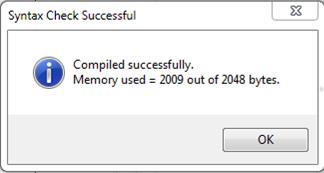
|
Copy and paste this subroutine into your program; it works. This subroutine was found on the internet. The original: 74HC595 Shift Register and PICAXE 18M2 Microcontroller
by Lewis Loflin
|